On August 8-10, 2002, 300-plus people from all parts of the globe came together to change the world. That was my impression of the Third International IIRP (International Institute for Restorative Practices) Conference on Conferencing, Circles and other Restorative Practices, held in Minneapolis, Minnesota.
As a reporter for the Delaware Valley News, which covers Bucks County, Pennsylvania and Hunterdon County, New Jersey, I wrote an article in the spring of 2002 about a documentary film being shot about the IIRP’s restorative practices techniques, in use in a Bucks County school district. IIRP president Ted Wachtel saw the article and asked me to visit one of IIRP’s Community Service Foundation (CSF) schools in Bethlehem, Pennsylvania where they also utilize restorative practices to record my impressions. Wachtel then asked me to cover the IIRP’s Minneapolis conference. In three days, I attended many conference sessions, interviewed numerous individuals for videotape and spoke to myriad participants. Folks had journeyed from as far away as Australia and New Zealand and hailed from places such as the United Kingdom, the Netherlands, Belgium, Sweden, Italy, the Antilles, the Philippines, the Middle East, Hong Kong, the Yukon and other parts of Canada and many of the United States, including Hawaii and Alaska. Also striking was the number of different Native American and First Nation peoples represented from the Nishnawbe-Aski, Ashinabe, Secwepemc, Qagan Tayagungin, Esketemc, Mille Lacs Ojibwe, Wet’suwet’en, Laksilyu, Navajo Mistawasis Cree, Mohawk and Tyendinaga, as well as other nations, clans and territories.
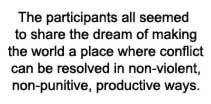 As the intense and busy days of the convention wore on, I was repeatedly struck by the selfless dedication of the group that had gathered. There was Bernadette Boschert, a guidance counselor from Tucson, Arizona who had paid her own way and admission to the conference after hearing about restorative practices on public radio and was determined to learn how to implement them in her school. There were Ivan Iserhoff, Lee-Ann Landry and Betty and Elbert Achneepineskum of Nishnawbe-Aski Legal Services Corporation, First Nation people who had driven all the way from Thunder Bay, Ontario, Canada to share their experiences with restorative justice in their community and learn what others were doing. From police, to teachers, to social workers, to mediators, to psychologists, to psychiatrists, to film producers, to authors, to clergy, to counselors, to attorneys, to administrators, all had come to change the world.
As the intense and busy days of the convention wore on, I was repeatedly struck by the selfless dedication of the group that had gathered. There was Bernadette Boschert, a guidance counselor from Tucson, Arizona who had paid her own way and admission to the conference after hearing about restorative practices on public radio and was determined to learn how to implement them in her school. There were Ivan Iserhoff, Lee-Ann Landry and Betty and Elbert Achneepineskum of Nishnawbe-Aski Legal Services Corporation, First Nation people who had driven all the way from Thunder Bay, Ontario, Canada to share their experiences with restorative justice in their community and learn what others were doing. From police, to teachers, to social workers, to mediators, to psychologists, to psychiatrists, to film producers, to authors, to clergy, to counselors, to attorneys, to administrators, all had come to change the world.
“Dreaming of a New Reality” was the name of the conference and indeed, the participants all seemed to share the dream of making the world a place where conflict can be resolved in non-violent, non-punitive, productive ways. But most of these dreamers did not seem to have their heads in the clouds. On the contrary, those at the conference working with restorative programs, whether under the name restorative practices, restorative justice, the Family Unity Meeting or family group conferencing, all seemed to be implementing very specific techniques and obtaining positive, substantiated results. These dreamers were employing conscious, purposeful systems to make a difference in people’s lives and had come to the conference to share their knowledge and achievements and to find encouragement, support and advice from others doing similar work.
A highly multi-cultural event, the conference was nevertheless remarkably united in its purpose. From the very beginning, numerous excited and focused conversations could be heard going on in every corner about restorative practices. At breakfast on day one, I sat next to Ingrid Cumberlidge of Alaska, a Native American former tribal judge and member of the Qagan Tayagungin Nation who had come to learn more about restorative practices to help the youth in her area, in the Aleutian Islands, “before they get involved with the State,” as she put it. Many of the kids she dealt with didn’t get services until they ‘’hit the felony level,’’ she said, and she was determined to change that situation.
To my left at the table was Bruce Barnes, a professor of conflict resolution and mediation negotiations in Honolulu, Hawaii. He said that he had been able to integrate a lot of Hawaiian cultural traditions in his work. It hit me then that I was seated between someone from Hawaii and someone from Alaska — a tidy coincidence, but also indicative of the conference’s wide reach.
Also at the table was Kathy Levine, a teacher from what she called the “ghetto area” of Duluth, Minnesota. Hers was a low-income “magnet school” for languages, she said, a place where Spanish and Ojibwa were taught to accommodate a multi-cultural population. Levine said that she had started restorative circles at the school two years ago and that the Native American parents were very taken with it. “They come with their grandmothers,” she said. Rounding out the table was Theresa Ozuna from Arizona, who said she did community dialogue circles and mediation. Kids really want to talk about a lot of issues, she said — molestation, rape — its adults who have the problem. She said that a common remark heard from the youth she worked with was, “I can’t believe you’re an adult, because you actually want to know what I think.”
The official proceedings of the conference began with welcoming remarks from Ted Wachtel. “All of us are dreamers,” he said. “We see the possibility of a future different from the present.” But, he said, it’s lonely to be a dreamer; that’s why these gatherings are important. Wachtel gave a history and overview both of the IIRP and circle conferencing and ended by saying that he hoped the conference would provide “a forum for anyone who shares the dream of a new reality based on restorative practices.”
Wachtel’s wife, Susan, IIRP’s vice president, introduced Vidia Negrea, a psychologist who is helping to open a Community Service Foundation school in Hungary. With an appealing soft-spoken manner and self-effacing humor, Negrea talked about her struggles as a social worker in Romania and Hungary and her internship at a Community Service Foundation school in Bethlehem, Pennsylvania. One of the most striking things she communicated was the way in which she learned to incorporate restorative practices into her own work.
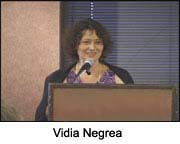
When Negrea became frustrated and overwhelmed by a particularly troubled young man at the school, she sought assistance from fellow staff members, thinking she was failing in her duties. It was a major revelation for her that asking for help from others, especially from the troubled boy himself, was not only “allowed”, but an essential part of the theory and practice of restorative practices. When Negrea let the boy know how his actions were affecting her and asked him to take responsibility for them, his behavior began to change for the better. Through this experience, Negrea discovered, first hand, the cornerstone of restorative practices — the thing that drives it and makes it work — doing things not for or to people — but with them. In sharing her personal immediate experiences, Negrea communicated an essential message to the conference.
There followed a vintage slide-show produced by Ted Wachtel in 1977 for a conference, “Social Work for a Change,” when the Community Service Foundation was just being incorporated. He had been looking for funds and kids at the time, running out of money and feeling hopeless, said Wachtel as he introduced the show. With slides ranging from panoramic shots of the American West to those of troubled youth and bombed-out urban areas, accompanied by inspirational quotes from Martin Luther King, Jr., Langston Hughes, Buckminster Fuller and Lao Tsu and songs from 25 years ago, the show was a moving and nostalgic trip back to a more innocent time remembered by the baby boomers attending the conference.
The slide show’s theme was American, but universal as well, as I realized when I heard two Swedish women next to me — who had been speaking to each other in their own language — softly singing along to Mitchell’s “Both Sides Now”, Dylan’s “The Times They Are A Changin’ “ and The Beatles’ “Let it Be”.
An unexpected shock of emotion swept the room when 1970’s photos of the World Trade Center came up on the screen, bringing us smack up against the present and reminding the group of the importance of the work to be done to restore real communication in the world.
The group broke up to go to the first sessions, people finding it hard to choose between the many fascinating alternatives on offer. I sat in a presentation by Terry O’Connell, the Australian ex-cop who pioneered the scripted restorative conference model that is influencing restorative practices in many countries around the world.
O’Connell used anecdotes and sought answers from the group to explore the difference between healthy and toxic systems and how to function effectively within them. “Don’t imagine that we’re going to change the system,” he said, adding, “The essence of what we’re on about is relationships.” He said it was paramount to “be very clear about what the hell’s happening — what the process is.” People need to feel that they’re being heard, taken seriously and understood, he said, and then they need to get feedback and accept responsibility for their actions. Their faith in the system can thereby be renewed. “We’re doing that intuitively,” said one audience member. “That’s the problem,” responded O’Connell and explained that “people need to do things deliberately, not intuitively.”
The first plenary speaker on Day Two was Chief Judge Heino Lilles, a territorial court judge in the Yukon since 1987. Exuding wit and power, Lilles talked about his experiences implementing restorative justice. Circle sentencing, he said — using a golf club metaphor — was “an oversized titanium driver.” Lilles took pains to point out that circle sentencing was not a slap on the wrist. He said that offenders had told him, “If I’d known how tough this is, I would have gone to jail.”
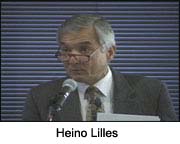
Lilles said that he did not use circle sentencing as a form of diversion. On the contrary, he said, in his court circle sentencing results in criminal sentences, replacing the formal sentencing hearing. But, while sometimes jail is the sentence, the reasons for jail time are quite different; it’s used almost exclusively in serious cases.
In Lilles’s courtroom, the victim does not have veto power over the decision to hold a circle because the community is also a victim. The restorative justice notion of crime as an injury to both the victim and the community is consistent with the culture of indigenous people.
Circles take on a life of their own, said Lilles. He used the analogy of dog sledding, which he has done himself. It’s easy — the dogs just go — until there’s a problem. You might get dumped off the sled or the dogs might fight and kill each other. “Any idiot, including a judge, can chair a circle when things are going well,” he said. But when things go wrong, that’s when an experienced facilitator can avert disaster.
Lilles said that he walks into a circle fully gowned in his judge’s robes. He removes them when he sits in the circle. This sends the message: “What I have to say is no more important than anyone else.” Introductions follow, then the professionals read the facts of the case or the offender is asked to relate them. The defense attorney reads some remarks and then “shuts up.” In a circle, said Lilles, the lawyers speak to the people in the circle, not to the judge. An eagle feather or some other “talking piece” is passed around the circle. Only the person holding it can speak.
Sometimes it takes a long time for a young male offender to speak, said Lilles, . There’s a lot of silence. But he always speaks. Sometimes emotions are so strong that the victim discloses things he or she has never before repeated. Many offenders, said Lilles, change their lifestyle and become restorative justice leaders in the community. Most victims, he said, don’t want to further punish offenders but want answers to questions.
Everything in a circle conference is recorded and transcribed and all legal safeguards apply, said Lilles. At first, he said, every circle had to be approved by the Crown. But, said Lilles, “they finally left us alone.” In the Yukon, judges have led the movement for restorative justice. Lilles called restorative justice “a wonderful tool for bridging cultures” because it demands a partnership between the community and the formal justice system. Some government agencies are very reluctant to participate in restorative justice. Solidifying these partnerships, said Lilles, will be the major challenge of the next few years.
Day Two’s second plenary speaker was Liz Quinnett, Manager of Training and Development for Health and Human Services in San Diego County, California. An extensive interview with Quinnett is covered below.
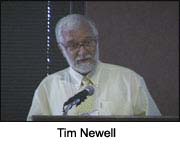
Day Three’s first plenary speaker was Tim Newell, a retired British prison governor who spent 37 years in the British prison system and successfully introduced restorative justice programs at Grendon and Spring Hill prisons. “Why work in prisons?” Newell asked. His answer: because that’s where the need is greatest. The victims, said Newell, are most seriously affected and the offenders are the most damaging and damaged. In England, 85–90 percent of young offenders and 55-60 percent of adults are convicted again within two years of their prison release. Prison costs £35,000 per year per person and 72,000 people are imprisoned every week.
The advantage of working in prisons is that people are contained and you can work within boundaries. In Grendon, the normal culture of fear in prisons is removed. There is a long list of prisoners waiting to get into Grendon, said Newell, because it’s a place they can actually achieve something for themselves and move on.
Restorative justice is very hard work in a prison, said Newell. “Why is it so hard to move the mainstream of the criminal justice system from doing the things we know don’t work to doing the things we do?” he asked. The resistance, he said, comes from the need of organizations to preserve their purpose.
Newell said that the conference had taken a big risk in asking him to speak because he was a Quaker. They could have gotten an hour of silence, he joked. On a serious note, Newell asked that there be no applause at the end of his speech. Then, with great eloquence, he summed up the essence of restorative justice with this quote, from the novelist Ian McEwen, about the horrors of September 11: “If the hijackers had been able to imagine themselves into the thoughts and feelings of the passengers, they would have been unable to proceed. It is hard to be cruel once you permit yourself to enter the mind of your victim. Imagining what it is like to be someone other than yourself is at the core of our humanity. It is the essence of compassion and it is the beginning of morality.”
The third day’s second plenary speakers were two high school principals from southeastern Pennsylvania — David Piperato from Palisades High School and Joseph Roy from Springfield Township High School. Public schools, they said, are in a key position to bring people together at a time when things like vouchers and charter schools are making them increasingly irrelevant. Public school change is essential now, they said, because of increased competition in educational choices, more stringent educational standards, pressure put on schools by businesses to train students in problem solving and other skills, as well as the rise in violence and drug and alcohol related problems.

But, said Roy and Piperato, while you can make changes in block scheduling, heterogeneous grouping and cooperative learning, these programs will fail without a change in the cultural foundation of the school. They defined cultural change as a change in people’s shared philosophies, ideologies, values, assumptions, beliefs, attitudes and norms. And, they added, you can’t separate the acquisition of knowledge from relationships. Positive relationships, they said, lead to increased safety and better academic performance.
When Roy was assistant principal at a high school in Bethlehem, Pennsylvania he suspended hundreds of students for thousands of days. He said the “dirty little secret” in public education was that the traditional system doesn’t work. What he learned was that with the kids with whom he made a connection, things started to change.
Roy and Piperato started the Academy, an alternative school, at Palisades High — a school within a school for students who were alienated. The teachers “busted their butts” in planning and implementing this project , said Roy. But student misbehavior was disrupting the innovative effort and “the teachers were ready to mutiny.” Along came Ted and Susan Wachtel and the IIRP’s SaferSanerSchools program. First the teachers in the Academy and eventually teachers throughout the high school learned to use restorative practices.
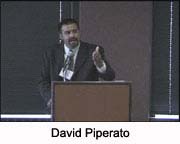
Piperato said that Palisades High had changed by “focusing on a new set of the three R’s: relationships, respect and responsibility.” Everybody, from students to teachers to administrators, is responsible for the success of the school. When someone comes to Piperato with a complaint his response is, “What are you going to do about it?” He stressed that restorative practices weren’t about excuse making, but about accountability and accepting consequences. Palisades High, said Piperato, had seen a dramatic shift since implementing the changes with restorative practices. Last year the school won a National Blue Ribbon Award.
The videotaped interviews I did made it clear to me that effective and concrete restorative methods are spreading throughout the world. All the interviewees were impressive in the passion they had for their work and in the scope of their accomplishments.
Paul Schnell, who is using restorative practices in his job with the St. Paul, Minnesota Police Department, has been a police officer for ten years. Schnell said that when he started out as a new cop, working in a school, he thought that, with his shiny new gun, badge and handcuffs, he would have an impact. But he didn’t. He found himself arresting kids, sometimes the same ones, over and over again. Then he had the opportunity to do restorative practices training with Terry O’Connell and Ted Wachtel and began to implement what he had learned. Some eight years later, he has facilitated hundreds of conferences in the neighborhood where he works and trained other officers in restorative practices techniques.
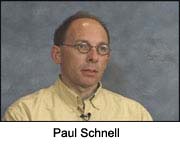
Schnell talked of using restorative language in every day police work. In the case of theft, for instance, when a cop asks questions beyond the normal “who, what, when and where” it can make an enormous difference. A simple question: “Tell me what this has been like for you?” or “What’s been the hardest thing about this experience for you?” helps the person who’s been through something as seemingly trivial as the theft of a set of golf clubs from their car deal with their feelings of loss and their concerns about safety.
Schnell spoke about a situation where one family in a community — two children in particular — was causing a great deal of trouble. They were damaging property, breaking windows and making noise. The cops were called in 50 or 60 times. They lectured the kids and the parents and still the problems remained. Then Schnell facilitated a conference attended by the family and many of their neighbors. The discussion, he said, was about what they wanted their neighborhood to be like. There was “heavy emotion”; the neighbors were quite upset. The difference was that the “trouble-makers” had been invited to be a part of the discussion for the first time. The outcome was extraordinary, said Schnell. In the following six months, police calls to the neighborhood all but ceased. The group, including the “trouble-makers”, had decided what they wanted their neighborhood to be like and how they were going to treat one another. Because it had been their decision, they had stuck by it.
Schnell also told the story of a man in prison for sexually assaulting a young girl. The man was in prison but the fallout from the crime remained. The man’s family was being targeted for abuse by the entire neighborhood. Schnell facilitated a conference with the parents of the victim, and the offender and his ex-wife. “It was excruciating,’’ said Schnell, “but it was also a phenomenal experience.” He was honored to be a part of the painful emotions exchanged in the conference. In the wake of the conference, the victimization of the offender’s family stopped immediately.
Restorative practices are spreading throughout Schnell’s department. His dream of the future includes formally applying restorative practices to the ways in which members of his department relate to one another as police officers, and in addressing such issues as racial profiling.
Matt Casey uses restorative practices at Family Support Services, a community agency in Goulbourne, New South Wales, Australia. He uses the scripted questions from the restorative conference in cases of domestic violence and other family problems. The questions – “‘What did you think about when this was happening? What have you thought about since? Who else has been affected by this and how? What’s the hardest thing about this for you?” — are the framework for engaging clients in an affective manner to allow them to express their emotions. He can then provide them with support to help them to “own their behavior unconditionally” and look at what’s necessary to change it. He always explains the theories behind what he’s doing to his clients, so that they understand why things are happening and it’s “not just magic” for them.
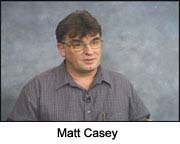
What’s amazing about the answers to the scripted questions, said Casey, is that often they’re not about the issue at hand, but much broader — about what they thought their life was going to be like. Clients can then begin to address what they can do to make their lives different and contemplate such questions as: “Where do I see myself in five years?”
It’s important, said Casey, that people not be allowed to “grab victim status.” That implies helplessness, meaning that they don’t have to take responsibility for their actions. Men, especially non-custodial fathers, tend to see themselves as victims, thinking that everyone is making demands of them.
Casey talked about the importance of separating judgement of people’s behavior from judgement about people themselves. He cited the case of a very angry man, a former biker, amphetamine abuser and alcoholic who had violently mistreated his wife and kids. She had left him and taken the kids. He came to Casey’s organization for help in obtaining unsupervised access with his kids.
Casey got the man to tell his story about his drug and alcohol abuse and violence. “Your behavior was outrageous, dreadful,” Casey told him, ‘I’d have left you too.” The man was furious, saying, “You can’t tell me that!” Then Casey told the man, “You’re alright; your behavior is outrageous,” making the distinction between the man and his behavior.
The man came back a week later and told Casey, “Meeting you was like being hit on the head with a pool cue.” Nobody had ever told him that his behavior was outrageous, but that he himself was alright. Casey and the man spent a lot of time talking. The man now attends Alcoholics Anonymous, has a job, does volunteer work and has unsupervised visits with his children. People need to be able to express emotion freely, said Casey, adding, “The minute we provided that chance a whole range of changes came in.”
Casey is excited about a new direction his organization is taking: working with people with disabilities and their families. In many cases, a crisis gets dealt with but behavior is never challenged. Often people with disabilities — such as developmental and mental problems — are aware of their differences and feel frustrated and ashamed because of them. But, he said, the same principles apply to people with disabilities as with anyone else and the same types of restorative questions can be used, to great effect.
Liz Quinnett, Manager of Training and Development for Health and Human Services in San Diego County, California developed the Family Unity Meeting in San Diego. Quinnett took us through the family meeting process as practiced in her unit of Child Welfare Services.
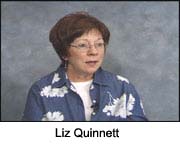
First is careful pre-meeting preparation. Parents have a chance to tell their stories and are told about the format and what to expect. Goals for the meeting are determined. Meeting participants include extended family and support systems, plus a facilitator and court-mandated social worker. It’s very important that the facilitator’s role is explained as neutral — just there to help keep the meeting on track to achieve the family’s goals.
The meeting begins with introductions of everyone present. This models respect and empowerment, said Quinnett, adding, “You can often tell by someone’s body language how they’ve been treated by the system and how their family has given up on them.” Parents are asked for permission to talk about their family issues. The family establishes its own ground rules for safety. Anger is okay, but safety must be maintained. Ground rules that come from the group are more likely to be followed. A lot of emotion comes up, said Quinnett, because people aren’t used to describing how they feel. A time-out might be called if things get too hot.
An essential phase of the meeting is the time used to describe the strengths of the parents, the family and the children. “Not many of us have the opportunity to sit in the bosom of our family and have them say what they think are our strengths,” said Quinnett. Many perpetrators have a very clear idea of what’s wrong with them, she said, and it’s very empowering for them to hear their strengths.
A break follows during which all participants share food together. This is very important, said Quinnett, because it breaks down the hierarchy in the room between the family and the professionals, emphasizing that everyone there is the same and that all are there together out of concern for the children. Furthermore, she said, “food soothes the savage beast.”
Then comes the time when people bring up painful history and current concerns. The latter are put into major categories. What follows is “Family Alone Time,” during which all professionals — social workers, facilitators, counselors, etc. — leave the room and the family develops its own plan for how to “put a safety net around the children.” Family Alone Time is very significant and powerful to families, said Quinnett. They’ve never been given that kind of trust before and they almost can’t believe it. She said that a critical part of the process was trusting that families can come up with their own solutions — that the social worker doesn’t have to be the magician. Her unit had found that people came up with more creative ideas without them. The entire group then reconvenes and the professionals make sure that court orders are being honored in any plan the family has devised. Then everyone gets to say how the meeting has been for them.
Quinnett said that she has never worked in a program that has had such positive outcomes. “I never fail to be amazed at what families can come up with,” she said. Her hope is that the sort of work done by the Family Unity Meeting can be part of every child welfare system some day. If more social workers, supervisors and managers could experience a meeting, she said, it would change their practice and improve the quality of their working life and probably the quality of their personal life, as well. “It would cheer them up considerably to see that there’s so much hope,” said Quinnett, adding, “Child abuse is not the end. To use a cliche: like any crisis, it’s also an opportunity.”
Gena Gerard is manager of the Minneapolis CCNP (Central City Neighborhoods Partnership) Restorative Justice Program. The program deals with livability and quality of life offenses such as chronic prostitution, drug dealing and use, public drinking and panhandling.

Gerard first became involved with restorative justice in 1996, when she researched the concept as a graduate student at the University of Minnesota. In 1997 she helped institute a pilot program, in partnership with the Minneapolis criminal justice system, which arranged for non-violent adult offenders to consider community conferencing as an option to resolve crimes.
Gerard said that space was created for community members and offenders to sit down and talk about the impact their behavior was having on neighborhoods, including “real people, businesses, churches, and children.” It gives people in the community a chance to do something more than call 911 or volunteer for a block patrol, said Gerard. Instead, in coming face-to-face with offenders, they can have a proactive role in the process and help repair the harm done to the community. Trained facilitators help with the conferences, during which plans are devised that are documented, signed and monitored. Offenders almost always choose to come back to the community to serve the needy, participate in community activities, apologize to those they have harmed, and make donations.
Gerard told a story about a cab driver that had been caught soliciting prostitution. He chose a restorative justice conference because he wanted to talk to someone; in court, no one had time to hear his story. The conference was very enlightening for him. As with most offenders, he had no idea who his crime had affected and when he heard from the community, he felt badly. Women in the neighborhood were being approached on the street and were afraid to walk to and from their homes. There was associated noise, traffic and littering. After the conference, he agreed to bring meals in his cab to homebound HIV patients and the homeless and continued doing so after his required community service had been completed.
The community takes a real leadership role in the program, said Gerard. They provide the direction in terms of structure, facilitating, deciding what cases to conference, guidelines, policy decisions and communicating with the criminal justice system. And, said Gerard, the effect in the neighborhoods has been extremely positive. Surveys given out after conferences have shown a 99 percent satisfaction rate. The program provides thousands of hours of community service to the neighborhoods each year while greatly improving relationships and safety in the community.
Gerard hopes that someday the criminal justice system will recognize that offenders can and should be held accountable, but that that doesn’t mean harsh punitive measures, more jail space or fining people and releasing them. Instead, it can mean positive interactions with other people and constructive outcomes for everybody involved.
Len Wildman and Tom Dwyer are, respectively, Manager of the Family Victim Services Center and Coordinator of Juvenile Accountability Conferencing (JAC) for the Rochester, New York Police Department. Wildman said that he first became interested in restorative justice when it became clear that the methods used with juveniles in his department weren’t working. He first got permission to contract with the IIRP to provide its Real Justice conference facilitator training for police officers and civilians in Rochester, then performed an experiment at a junior high school. In a year, his officers did 40 conferences. It was very successful, said Wildman.
He subsequently got a grant to implement a three-year restorative justice program, which has been equally effective, with a 93 percent success rate. The juveniles they’ve dealt with haven’t come “back into the system.” Most of the offenses JAC concerns itself with involve juveniles under 15 years of age and minor non-felony offenses, but there are exceptions.
Wildman said he had been a little frightened at the idea of bringing restorative justice into his city of 250,000 people because he had not been aware of its previous use in such a populous and multi-ethnic community. “I don’t have that concern now,” he said.
Dwyer has coordinated 140 conferences to date. “I got goose bumps from the 140th just like from the first,” he said. A major part of the work has entailed meeting and educating participants in the process. Feedback from victims, offenders and their supporters has been exceptional; many wondered why these methods hadn’t been tried years ago. “People don’t want to go to court,” said Dwyer. “They’d much rather be part of a process that gives them a chance to express emotion.”
Wildman mentioned one conference that took place soon after the school shooting incident in Columbine, Colorado. A 14 year old boy was standing outside his school waving a replica of a Beretta handgun — the same kind used by the Rochester Police Department. The boy was arrested for harassment, but the arresting officer was concerned that he didn’t understand the distress he had caused.
Dwyer set up a conference so the boy could hear from people who had been affected by his actions. A man had watched the incident from the second floor of a building across the street, unable to hear anything; he could only see. Too frightened to attend the conference, he sent a letter to be read. When the child heard it, he broke down and cried. At that point he began to feel the impact of what he had done. He also found a lot of support at the conference, learning that people were not out to get him. The boy has never caused another problem, said Dwyer.
Wildman called the program a “win-win situation for the community and the police department.” But people have to see it in action before they embrace it. That’s why it can be difficult to market, he said. Arresting officers are required to be part of the conference. The officers are invariably won over to the process and they tell their fellow officers about it.
The Rochester Police Department has been very successful in getting community service agencies involved in the JAC program to provide community service options for juveniles as part of their conference outcomes, said Wildman. A potential mentoring program has grown out of that situation.
Wildman told of another restorative program used by his department. His city has 45 homicides a year, about one a week. Whole neighborhoods suffer from the pain a homicide causes. In response, a van goes into each neighborhood where a homicide has been committed and volunteers go door to door to ask people how they have been affected by the incident. In the van, police officers, the district attorney in charge of the case and trained counselors are available. In three years, 20,000 households have been covered in this program. The communities seem to truly appreciate it, he said.
Wildman said that he had begun to implement restorative practices within his own section of the police department. He talked about the Finger Lakes (New York) Restorative Justice Consortium which is implementing restorative practices in his region. Wildman hopes that they will be instrumental in spreading the kind of work his department has been doing to a wider area.
Lorenn Walker is a lawyer, public health educator and former Deputy Attorney General of the State of Hawaii who designs violence prevention, conflict resolution and resiliency development programs for juveniles and adults in Oahu, Hawaii. She recently oversaw a juvenile conferencing program in conjunction with the Honolulu Police Department in which 85 conferences took place. The results were exciting, said Walker. Surveys were taken with 405 people who participated in the conferences and almost all were favorable. 90 percent of the juveniles complied with the plans agreed upon in the conferences. The project really educated police, said Walker. The criminal justice system in Hawaii is completely offender based. It was a revelation for them to see the importance of victims in that process, she said.

Walker has been facilitating conferences since 1997. She had the experience of participating in a conference directly when her son — a seventh grader at the time — was assaulted in school. The boy who punched her son was expelled and Walker was unhappy about that. The north shore of Oahu, said Walker, is predominantly non-white and her family is white. Consequently, she feared that the boy’s expulsion might make her son a target for more trouble.
The conference was an amazing experience for Walker. Even though she had facilitated many conferences and knew all the theory, she couldn’t have predicted how she would feel as a participant. She had very negative feelings about the offending boy’s father, thinking him a “lowlife”. He, in turn, thought she and her husband were “born with silver spoons in their mouths.” As a result of the conference, Walker realized that the father was doing the best he could for his children. He learned that Walker had been on her own since she was 14 and had worked her way through college and law school. Three years later, Walker, her husband and the boy’s father are friends and so are the boys. From the conference process, her son also learned how to express his feelings. The offending boy hasn’t assaulted anyone else.
Walker is working on a new project with the IIRP and the Hawaiian Friends of Civic and Law Related Education to develop a process for victims of crimes where there’s no known offender. Victims in these cases are particularly disenfranchised by the system, said Walker, and 70 percent of crimes fall into this category. Ninety percent of criminal defendants plead guilty with a plea bargain. “We spend all of our resources on trials and proving guilt,” said Walker. She believes it would make more sense to put resources into dealing with victims who are left without any kind of healing process.
Walker, herself a victim of a very violent crime at the age of 24, said that a lot of victims don’t know how to get the help they need after such incidents. They feel deep shame, as though the crime was their own fault. Friends and relatives shy away from talking with victims, as it makes them uncomfortable. Said Walker, “We need to provide a forum for victims to tell their stories so other people can connect with us and help us heal.” She added, “Group process is the missing piece of our criminal justice system, especially for victims where there’s no known offender.”
Rob van Pagee is director of Op Kleine Schaal, in the Netherlands, a 20 year old child welfare and child protection agency. He has worked and trained in all the Scandinavian countries plus Belgium and Central and Eastern Europe — including Hungary, Poland, Slovakia, Estonia and Russia. Van Pagee works with two restorative models: the Real Justice scripted conference and the Family Group Conference (similar to the Family Unity Meeting explained above by Liz Quinnett). The former, he said, “provides a safe place for victims and offenders and their families ... to discuss what happened and make a plan to repair the harm.” He is using that model mainly in child and youth welfare and protection cases, but it is moving into prisons as well. The latter model, said van Pagee, brings families of children together so they can take responsibility for the welfare of the child.
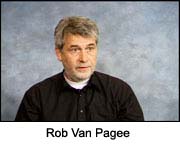
Van Pagee started out as a social worker. “Families used to put all their problems on my plate,” he said. He made a plan for them with his supervisor and sold it to the client. It didn’t work, he said. The system has been getting more and more medical, doing things for the clients, not with. He felt that should change. What is happening now, he said, is a “paradigm shift” in the traditional process — putting people in position to take responsibility for themselves. Van Pagee sees an opportunity now to change the system. But changing the system is going to be a very big challenge. “We have pilots all the time,’’ he said, “pushing, pulling. But people in power are resistant to the change.”
On the other hand, people who participate in the program are eager to do so. “When I offer Family Group Conferencing to people they come in quite big numbers,” he said. And satisfaction with the process is very high: 80 percent. “We don’t have to train families to do this,” he said.
Problems arise when plans decided in conferences come up against limitations presented by the system. Van Pagee cited the example of a drug-addicted woman with three children. The Family Group Conference came up with a plan, approved by all the social workers, in which the woman would be aided by members of her extended family and friends while she obtained treatment. But she and her children needed to move to an area outside the drug-related neighborhood. That meant involving the housing department, which sat on the application for months. They ended up having to offer the woman out of home placement for her children. This was a shame and waste, as a house rental would have cost $500 to $1,000 per month, while placing three children cost seven times that amount.
What’s needed, said van Pagee, is a donor conference, with all the service organizations participating, to follow the Family Group Conference. A pilot program for this idea is now in process, said van Pagee.
Van Pagee finds the idea that the family is the highest authority “very exciting.” But, he said, “Some people say; ‘You’re never going to make this happen without changing the law.’ “ The problem is, laws don’t change overnight. Advocacy groups are needed to make it happen. “This is more than I’ve ever done and been involved with,” said van Pagee.
Van Pagee has participated in 70 restorative justice conferences, mostly involving youth welfare cases. “Everyone knows how beautiful it is to see people solve their problems together,” he said. But it’s not easy to implement the process within the criminal justice system. However, in the Netherlands, the Prosecutor General’s Office has taken the position that restorative justice is valuable in the criminal justice system. That’s very important. The office did state conditions: that restorative practices should serve the needs of the victims; that they be voluntary; that they be transparent (open to all); that there be no plea bargains up front; and that the restorative plan becomes part of the legal procedure so every prosecutor has to look at it. He (or she) can’t reject it out of hand.
Van Pagee is hopeful that these developments will lead to possible system change. He believes that restorative practices should be offered to everyone, including victims. But he thinks that a great deal of work still needs to be done to familiarize people with the process. “When you ask people: What is justice, they say — police, prosecutors, a judge, jail. But when you ask: What is restorative justice? Nobody knows.”
Nancy Riestenberg is a prevention specialist with the Minnesota Department of Children, Families and Learning, a program using a whole range of restorative practices in public schools. Restorative practices, she said, have changed the way people do their jobs and their attitude toward their jobs. They help people make a connection between students and teachers and make the atmosphere in a school more comfortable and respectful. What’s wonderful to see, she said, is when kids take the initiative to hold a circle in the playground, taking care of a problem themselves.
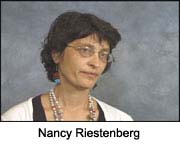 The reason an offender does what he does, said Riestenberg, is that he doesn’t know how to empathize with someone else. In restorative practices, she said, you create a place where empathy can happen. And if you can get people to empathize with each other, they’re much less likely to hurt one another.
The reason an offender does what he does, said Riestenberg, is that he doesn’t know how to empathize with someone else. In restorative practices, she said, you create a place where empathy can happen. And if you can get people to empathize with each other, they’re much less likely to hurt one another.
Riestenberg’s department got a grant from the Minnesota state legislature to evaluate results of restorative practices in four districts: one urban, one suburban and two rural. In one school where circles were used, the number of violent incidents went from seven a day to one a day over a two year period. Behavior referrals to the office went from 1600 to 450 over three years.
It was not strictly research that her department did, said Riestenberg, but gathering information on preliminary outcomes. They found that to make change happen in a school takes at least two to three years. Even with desire, energy and resources, she said, it takes time. Second, to measure impact, people need to gather data and be honest about the number of suspensions, expulsions, etc. The numbers, though, don’t tell the whole story. It’s easy to gather information on offenders, but harder to gather information on victims or the community. Nobody keeps those numbers, she said. What you have to do is put numbers and stories together.
Riestenberg also learned that if you just have a restorative intervention program, “that will get you someplace.” If you just have classroom management skills that are cognitively based and are about solving problems rather than using power and control over kids, “that will also get you someplace.” But if you use the two together, you will get much farther; the whole school becomes congruent.
Riestenberg told a story about a suburban school involving four third grade boys — three African American and one European American. The European American boy called the other boys a racial slur. This was considered racial harassment and the boy could have been suspended for two to three days. Instead, the boys agreed to sit in a circle and talk, with a facilitator present. The three African American boys had the opportunity to tell the other boy what the racial slur meant to them personally.
For one boy, it was: “the word a white man used when he shot my uncle in the head.” For the second, it was: “the word those men in white sheets use in the movies when they go to burn down people’s houses.” The third boy said, “When I hear it, it hurts my heart so much I have to get away.” The white boy didn’t know how powerful the word was when he used it, but, said Riestenberg, “He certainly does now.” The three African American boys wanted the European American boy to make amends by becoming their friend. Their friendship has lasted several years.
Asked what advice she had for people who wanted to bring restorative practices into schools, Riestenberg said, “Just do it,” then elaborated, “Decide on your sphere of influence and start there.” It can begin on the grass roots level or on a higher level. It should always be voluntary, as that’s one of the basic tenets of restorative practices. “Also,” she said, “let go of the idea that everyone in the school system has to do this.” She called that: “the road to exhaustion.”
Look for advocates, go where the strengths are and be clear that you’re not replacing what’s already there, but adding to it. “If a kid brings a knife to school and you take it away,” she said, “you have to replace it with something.” The kid brought the knife thinking they needed to defend themselves and if you take it away they’ll feel vulnerable. You have to fill that space up with skills, resources and support. The same thing is true for administrators. If you take away their discipline system they feel vulnerable.
Seek out skeptics and ask them to help you. “We need people who say, ‘I’m not sure this will work.’ They’re the people who hold us accountable.” In inviting the skeptics to do their jobs, she said, you give them something useful to do and then they won’t feel the need to sabotage you. Their criticism will be given in the spirit in which it is needed. Involve kids in the training. They offer an enormous amount of wisdom and perspective.
In conclusion, Riestenberg said she was concerned that people didn’t co-opt the term “restorative practices” just to appease people. Also, she hoped that schools would someday be able to attend to the needs of victims, not just focus on offenders.
Betty Achneepineskum and Ivan Iserhoff are Canadian First Nation restorative justice workers with Nishnawbe-Aski Legal Services in the Thunder Bay, Ontario area. Restorative justice has always been a concept that Achneepineskum has valued because it’s a part of her culture and tradition. She sees it as a process that can help her people, especially those in correctional facilities. In some of the districts where she works, the inmate population is 75 percent First Nations people. “We know the system that’s in place doesn’t work for our people,” she said. She sees restorative justice as a way of helping her people “beyond the point of punishment.”
Iserhoff worked in the court system for several years investigating police officers in Ontario, geared toward Native complaints. Native people tend to be silent, he said, reluctant to trust any government services because of the bureaucracy and slowness of the system. When he came to Nishnawbe-Aski Legal Services, Iserhoff “took the bull by the horns.” “This is what we used to do,” he said, adding, “It’s the only way we’re going to help our people.” However, it’s a slow process, a matter of people hearing about it and seeing the results.
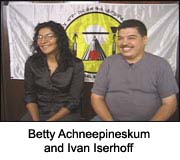 Achneepineskum said that she saw restorative justice not only as an alternative to the Euro-Canadian justice system but as a healing process for her people. Alcohol and drug related charges and venting of anger stem from underlying causes, she said, such as dysfunctional families and sexual abuse.
Achneepineskum said that she saw restorative justice not only as an alternative to the Euro-Canadian justice system but as a healing process for her people. Alcohol and drug related charges and venting of anger stem from underlying causes, she said, such as dysfunctional families and sexual abuse.
Iserhoff is using restorative justice to deal with a range of issues including incest, sexual assault, assault with a weapon, breaking and entering, fraud and vandalism. The principle agreement with the Crown Attorneys, he said, was to deal first with lower offenses. Now his group is beginning to gain credibility with the Crown. “It will benefit the Crown,” he said, “because they’ll have to deal with less crime. It’s evident in the numbers.” The charges his organization deals with will gradually become more serious, he said.
Iserhoff is reluctant to invite lawyers and Crown Attorneys into circles. They’re only present to observe the dynamics and emotions of the process, he said, because Native people are very shy. When the attorneys witnessed a circle in a sexual assault case, however, “it blew them out of the water.”
Achneepineskum said that restorative justice had been effective in preventing crime, especially in cases of domestic abuse. When couples get together in a circle they see how their actions have affected each other, their children and their community, and it gives them a different perspective on how to deal with the issues. They also identify treatment, resources and services for their families. “We feel very positive when a couple sets out their own agreement,” she said. Iserhoff told about a spousal abuse case in which a couple went through a restorative justice circle. After attending counseling sessions, he said, they’re helping other young people in the community. This is a sign the process is working.
Asked about the similarity of Native culture with restorative justice, Achneepineskum said that respect is a very strong component of both. She must deal with diverse cultures in her community — some Christian, some observing traditional values — and she must have respect for them all. Honesty is another value common to both. She must honor the values of respect and honesty to gain credibility in the community, she said.
Iserhoff talked about a circle which focused on assault with a weapon. After the circle was done and the two boys had worked things out and forgiven each other, a grandfather came up to Iserhoff and whispered in his ear in his own language, “This is what we used to do a long time ago.” The grandfather was glad to see the old ways being used again. Iserhoff was very touched by the elderly man’s response. It made him feel like a servant to his people — like he was meant to be there, doing what he was doing.
Asked about her hopes for the future of restorative justice in her community, Achneepineskum said that she had a personal vision of a time when they would no longer have the Euro-Canadian justice system coming into their community, but could deal with their own issues. Said Iserhoff, ‘’We talk about self-government, but the only time we’ll ever see it is when we totally take over our own system.” He dreams of a time when his community has no ties to the court system and no government agencies telling them what to do. Native people lead the statistics in every category — suicides, alcoholism... “That’s got to change,” he said. “We’ve got to stop blaming people and just get on with our lives and try to better our situation. What’s done is done,” he said, “1492 was a long time ago.”
I left the conference filled with hope about the future of restorative practices, restorative justice, circles and conferencing. Learning about the ways in which the techniques are being used successfully all over the world was extremely encouraging. Happily, restorative principles seem to be contagious.
Many of the locations where restorative practices are being used now seem to be on the small side — schools, smaller communities. But one can dream. My dream is that someday circle conferences will be used to help make peace between Catholics and Protestants in Northern Ireland and between Palestinians and Israelis. I dream that someday restorative practices will be used to improve the quality of life in big cities with high crime rates like New York and Los Angeles.
It will take, as Rob van Pagee called it, “a paradigm shift.” But God knows we need it. One need only look at the skyline of lower Manhattan, where the World Trade Center once stood, for proof. And the “war on terror” and invading Iraq will do nothing to repair the harm done on that dreadful day.
Still, I’m hopeful. I attended the conference session led by Mark Green, counsel with the Canadian Department of Justice who helped plan the United Nations Experts’ Meeting on Restorative Justice. If an organization on the scale of the United Nations is beginning to recognize restorative justice as viable, perhaps there is hope for our world, yet. We must keep dreaming and keep working . . .

